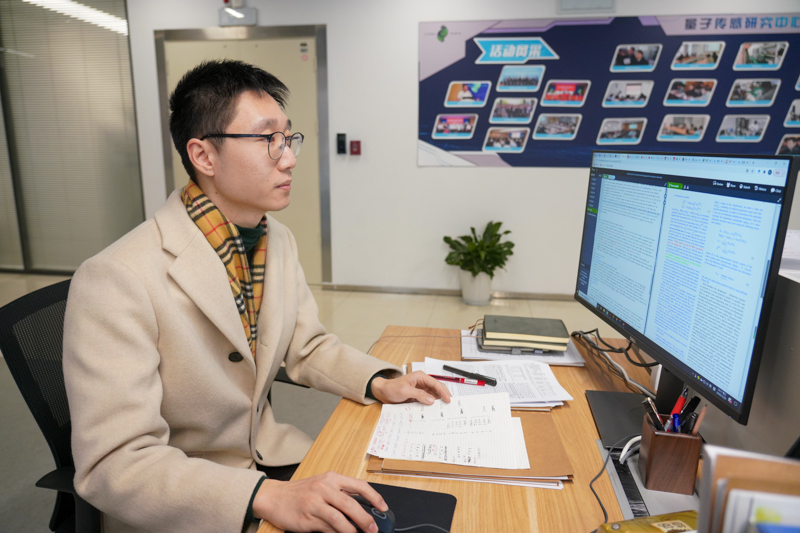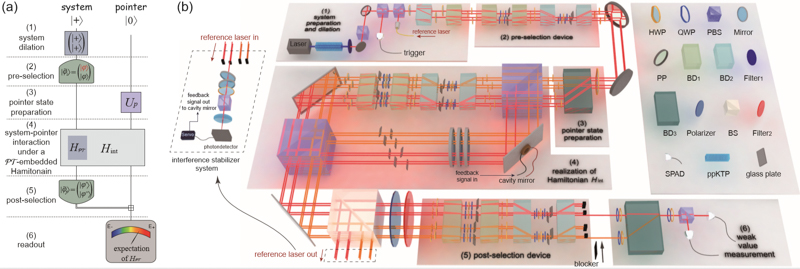


Yu Shang, postdoctoral researcher at Zhejiang Lab

Spatial Symmetry and Time Reversal

(a) Logic diagram of the construction of the 𝒫𝒯-enhanced system. (b) Experimental setup.

The enhancement of sensitivity by using quantum sensors compared to classical sensors in the case of unbroken (a) and broken (b) parity-time (𝒫𝒯) symmetry. The black circles and red lines represent the experimental results and theoretical values, respectively. The blue dashed lines represent the numerical-simulation results and the light-blue shaded areas represent the deviations of simulated results.
In a joint research project with the University of Science and Technology of China (USTC), Yu Shang, a postdoctoral researcher at Zhejiang Lab, recently achieved significant outcomes with his team in the study of 𝒫𝒯-symmetric quantum sensors. The results were published in a paper entitled "Experimental Investigation of Quantum 𝒫𝒯-Enhanced Sensor" in Physical Review Letters, an internationally renowned journal.
Space and time are among the oldest concepts in human civilization. In the physical world, a 𝒫𝒯-symmetric system is a physical system that keeps its properties and characteristics unchanged through spatial symmetry and time reversal.
In recent years, 𝒫𝒯-symmetric theory has extended quantum mechanics to a more complex region. In this study, Yu and his team construct a quantum 𝒫𝒯-symmetric system assisted by weak measurement, which can effectively transit from the unbroken region to the broken region. The full energy spectrum including the real and imaginary parts is directly measured using weak values. Furthermore, based on the ability of approaching a broken region, the team for the first time translate the previously mentioned 𝒫𝒯-enhanced sensor into the quantum version, and investigate its various features that are associated to the optimal conditions for sensitivity enhancement.
The experimental results show that, when the 𝒫𝒯-symmetric system is operated at an exceptional-point (EP, the branch point distinguishing the broken and unbroken regions), the sensitivity of this quantum sensor is enhanced 8.856 times compared to the conventional Hermitian sensor. Moreover, by separately detecting the real and imaginary parts of energy splitting, it can derive the additional information of the direction of perturbations.
Besides photonic system, other quantum systems can also be used to construct a 𝒫𝒯-symmetric system, and hence a quantum sensor. As these sensors, especially single spin, usually have small sizes compared to classical EP-based sensors, therefore, they can be used to detect the local physical quantities at the single- or few-atom level, such as the magnetic field of single molecule. Therefore, this study will provide guidance for the design of this type of similar high-sensitivity quantum sensors. In addition, based on the quantum nature of the experiment, entanglement and other quantum resources can be introduced into the 𝒫𝒯-enhanced sensor, which will help further improve the capabilities of this sensor, especially its sensitivity.
This work was highly recognized by the reviewers. "The experiment is very interesting and highly relevant. A very high impact to the field of non-Hermitian physics and 𝒫𝒯-symmetry can be expected. This is a major step forward since a true quantum sensor operated at an EP is shown to work. This is definitely of broad interest," one reviewer said.
Zhai Yueyang, a researcher at the Zhejiang Lab Research Center for Quantum Sensing, said that this work has positive implications for the construction and development of the center. "In the future, we intend to simulate this 𝒫𝒯-symmetric system on facility for ultrasensitive quantum measurement of inertia, hoping to improve the facility's sensitivity. We will apply the system to the ultrasensitive detection of physical quantities such as extremely weak magnetic fields and inertia, to further support the development of technologies such as inertial navigation and the measurement of electric dipole moments," said Zhai.
Yu Shang, a postdoctoral researcher at the Zhejiang Lab Research Center for Quantum Sensing, is the first author of the paper. USTC Professor Li Chuanfeng and Professor Tang Jianshun are the corresponding authors.
For full text of the paper, please refer to
https://journals.aps.org/prl/abstract/10.1103/PhysRevLett.125.240506














